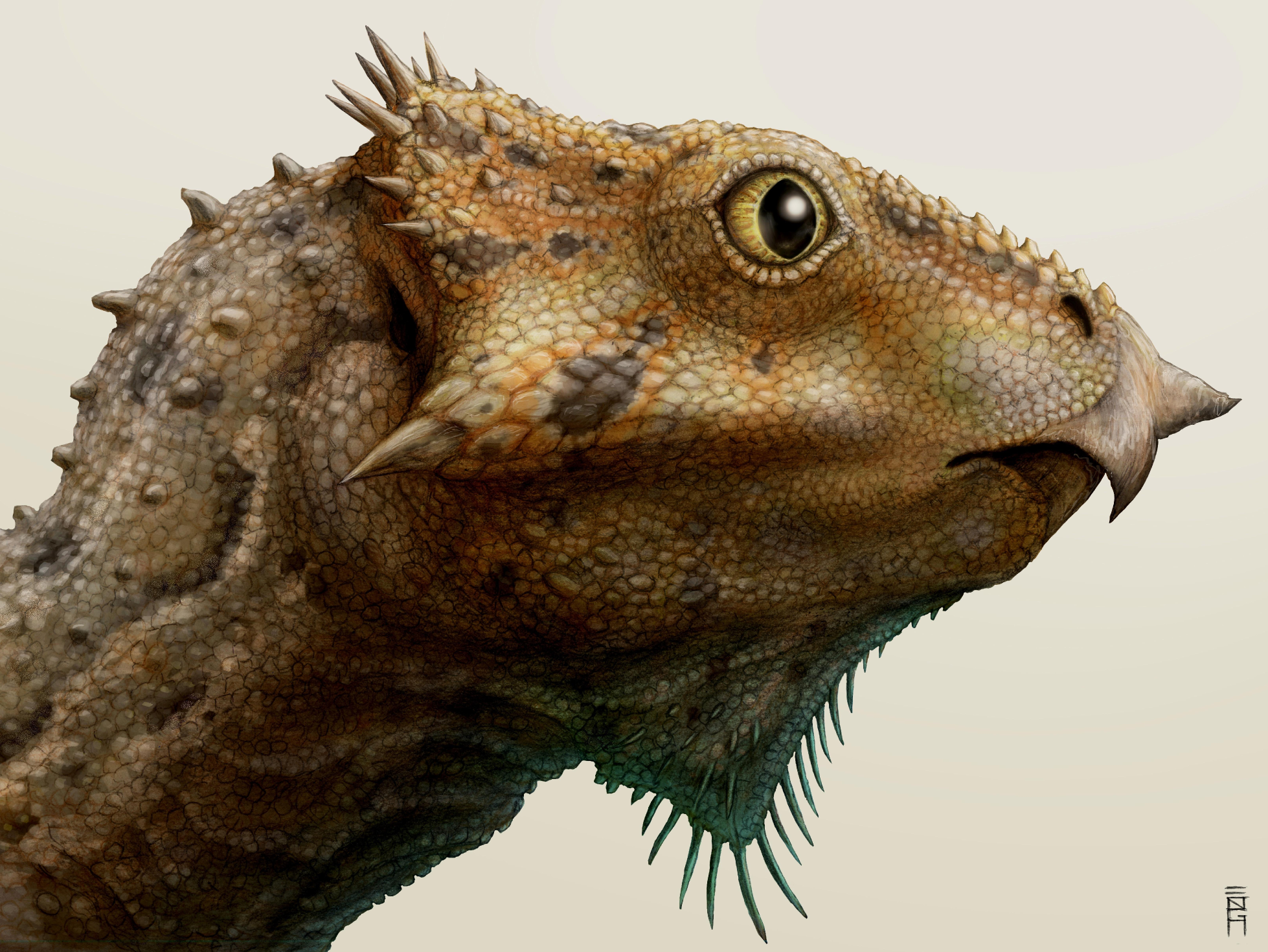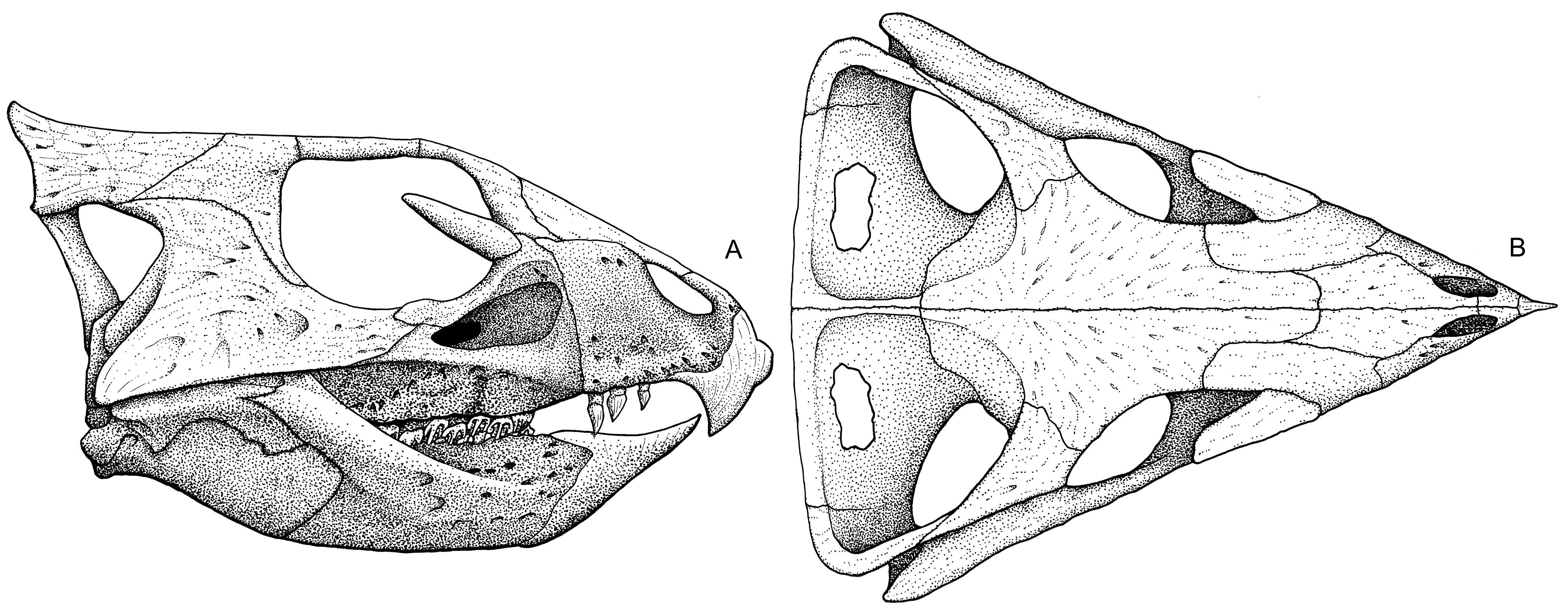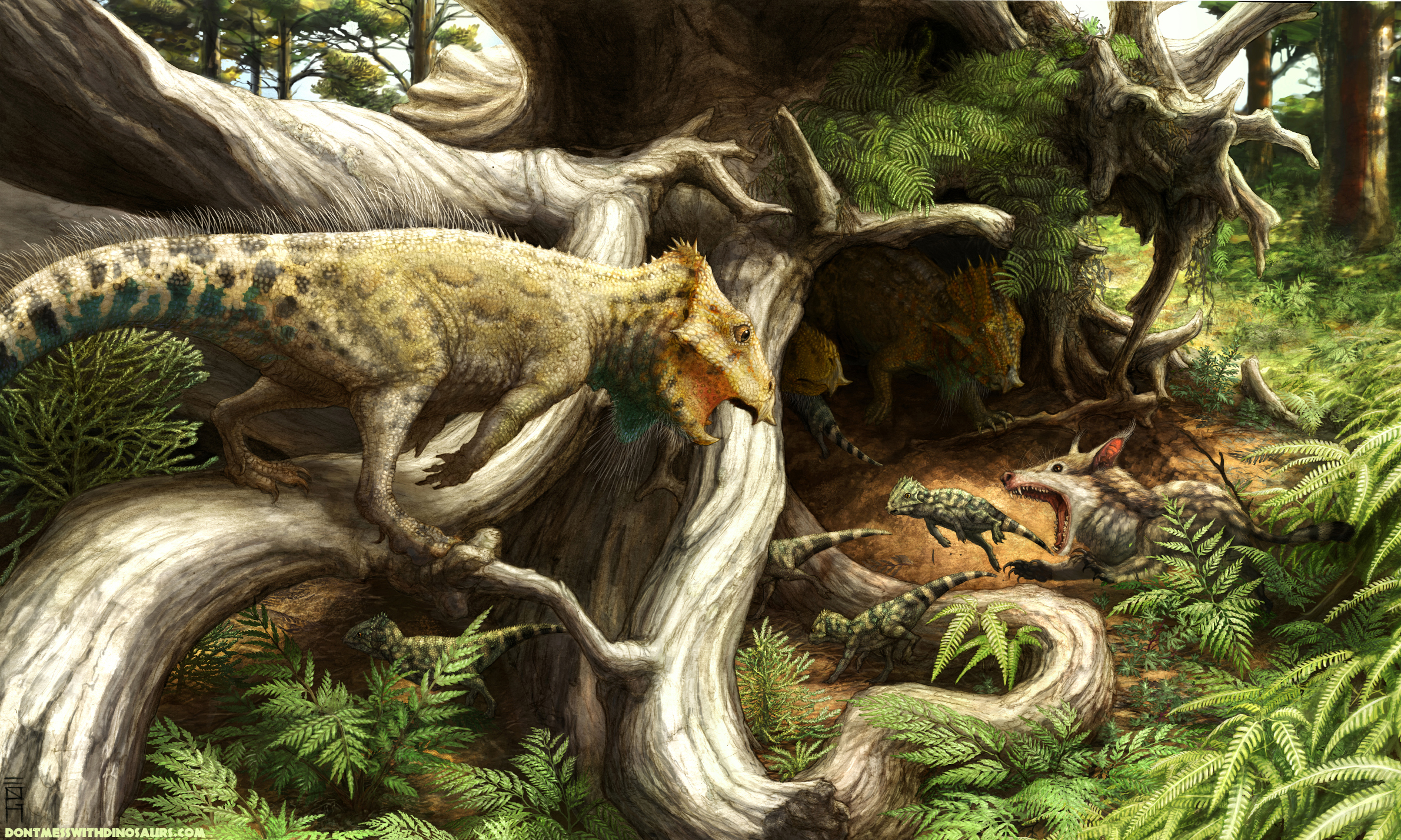|
Aquilops Skull
''Aquilops'' is an early herbivorous ceratopsian dinosaur dating from the Early Cretaceous of North America, approximately 109 million to 104 million years ago. The type species is ''A. americanus''. Description The skull is 84.2 mm long. The holotype is possibly not from a full-grown individual. A comparison with related species indicates it might have been at 60% of its adult length. Wedel estimated the total body length of ''Aquilops'' at 60 cm and its weight at 1.5 kg. The authors established some unique traits. The rostral, the bone core of the snout beak, curves downwards and has an arched keel on its top with a bump on the front. In front of the tooth row the upper jaw rim is over its total length concave in side view. The skull opening, the antorbital fenestra, is twice as long as it is tall and has a pointed rear, below the eye socket. Discovery and naming In 1997, paleontologist Scott Madsen found the single fossil, a partial skull, in Carbon County ... [...More Info...] [...Related Items...] OR: [Wikipedia] [Google] [Baidu] |
Early Cretaceous
The Early Cretaceous ( geochronological name) or the Lower Cretaceous (chronostratigraphic name), is the earlier or lower of the two major divisions of the Cretaceous. It is usually considered to stretch from 145 Ma to 100.5 Ma. Geology Proposals for the exact age of the Barremian-Aptian boundary ranged from 126 to 117 Ma until recently (as of 2019), but based on drillholes in Svalbard the defining early Aptian Oceanic Anoxic Event 1a (OAE1a) was carbon isotope dated to 123.1±0.3 Ma, limiting the possible range for the boundary to c. 122–121 Ma. There is a possible link between this anoxic event and a series of Early Cretaceous large igneous provinces (LIP). The Ontong Java-Manihiki-Hikurangi large igneous province, emplaced in the South Pacific at c. 120 Ma, is by far the largest LIP in Earth's history. The Ontong Java Plateau today covers an area of 1,860,000 km2. In the Indian Ocean another LIP began to form at c. 120 Ma, the Kerguelen P ... [...More Info...] [...Related Items...] OR: [Wikipedia] [Google] [Baidu] |
Latin
Latin (, or , ) is a classical language belonging to the Italic branch of the Indo-European languages. Latin was originally a dialect spoken in the lower Tiber area (then known as Latium) around present-day Rome, but through the power of the Roman Republic it became the dominant language in the Italian region and subsequently throughout the Roman Empire. Even after the fall of Western Rome, Latin remained the common language of international communication, science, scholarship and academia in Europe until well into the 18th century, when other regional vernaculars (including its own descendants, the Romance languages) supplanted it in common academic and political usage, and it eventually became a dead language in the modern linguistic definition. Latin is a highly inflected language, with three distinct genders (masculine, feminine, and neuter), six or seven noun cases (nominative, accusative, genitive, dative, ablative, and vocative), five declensions, four verb conjuga ... [...More Info...] [...Related Items...] OR: [Wikipedia] [Google] [Baidu] |
Liaoceratops
''Liaoceratops'', meaning "Liaoning horned face", is a ceratopsian dinosaur believed to be an early relative of the horned ceratopsids. It lived in the Early Cretaceous, 126 million years ago. It was discovered in China by a team of American and Chinese scientists. ''Liaoceratops'' was much smaller than its later relatives, but offers a glimpse into the early evolution of this group of dinosaurs. Discoveries and naming ''Liaoceratops'' was discovered in the famous Liaoning Province of China, where several fossils of feathered dinosaurs have also been collected. The type species ''Liaoceratops yanzigouensis'' was in 2002 named and described by Xu Xing, Peter Makovicky, Wang Xiaolin, Mark Norell and You Hailu. The generic name is derived from Liaoning and the Greek ''keras'', "horn" and ''ops'', "face". The specific name refers to the town Yanzigou. The holotype IVPP V12738 has been found in the Yixian Formation dating from the Barremian. These beds have also yielded fossil ... [...More Info...] [...Related Items...] OR: [Wikipedia] [Google] [Baidu] |
Leptoceratops
''Leptoceratops'' (meaning 'Thin-horned face' and derived from Greek ''lepto-/λεπτο-'' meaning 'small', 'insignificant', 'slender', 'meagre' or 'lean', ''kerat-/κερατ-'' meaning 'horn' and ''-ops/ωψ'' meaning face), is a genus of leptoceratopsid ceratopsian dinosaurs from the late Cretaceous Period (late Maastrichtian age, 68.8-66 Ma ago) of what is now Western North America. Their skulls have been found in Alberta, Canada and Wyoming. Description ''Leptoceratops'' could probably stand and run on their hind legs: analysis of forelimb function indicates that even though they could not pronate their hands, they could walk on four legs. Paul proposed that ''Leptoceratops'' was around long and could have weighed , but Tereschenko proposed a maximum length of . Discovery and species The first small ceratopsian named ''Leptoceratops'' was discovered in 1910 by Barnum Brown in the Red Deer Valley in Alberta, Canada. He described it four years later. The first specimen ... [...More Info...] [...Related Items...] OR: [Wikipedia] [Google] [Baidu] |
Cladistic
Cladistics (; ) is an approach to biological classification in which organisms are categorized in groups (" clades") based on hypotheses of most recent common ancestry. The evidence for hypothesized relationships is typically shared derived characteristics ( synapomorphies'')'' that are not present in more distant groups and ancestors. However, from an empirical perspective, common ancestors are inferences based on a cladistic hypothesis of relationships of taxa whose character states can be observed. Theoretically, a last common ancestor and all its descendants constitute a (minimal) clade. Importantly, all descendants stay in their overarching ancestral clade. For example, if the terms ''worms'' or ''fishes'' were used within a ''strict'' cladistic framework, these terms would include humans. Many of these terms are normally used paraphyletically, outside of cladistics, e.g. as a 'grade', which are fruitless to precisely delineate, especially when including extinct species. R ... [...More Info...] [...Related Items...] OR: [Wikipedia] [Google] [Baidu] |
Neoceratopsia
Ceratopsia or Ceratopia ( or ; Greek: "horned faces") is a group of herbivorous, beaked dinosaurs that thrived in what are now North America, Europe, and Asia, during the Cretaceous Period, although ancestral forms lived earlier, in the Jurassic. The earliest known ceratopsian, ''Yinlong downsi'', lived between 161.2 and 155.7 million years ago.Holtz, Thomas R. Jr. (2011) ''Dinosaurs: The Most Complete, Up-to-Date Encyclopedia for Dinosaur Lovers of All Ages,'Winter 2010 Appendix./ref> The last ceratopsian species, ''Triceratops prorsus'', became extinct during the Cretaceous–Paleogene extinction event, . ''Triceratops'' is by far the best-known ceratopsian to the general public. It is traditional for ceratopsian genus names to end in "''-ceratops''", although this is not always the case. One of the first named genera was ''Ceratops'' itself, which lent its name to the group, although it is considered a ''nomen dubium'' today as its fossil remains have no distinguishing characte ... [...More Info...] [...Related Items...] OR: [Wikipedia] [Google] [Baidu] |
Aquilops Cranium Scan
''Aquilops'' is an early herbivorous ceratopsian dinosaur dating from the Early Cretaceous of North America, approximately 109 million to 104 million years ago. The type species is ''A. americanus''. Description The skull is 84.2 mm long. The holotype is possibly not from a full-grown individual. A comparison with related species indicates it might have been at 60% of its adult length. Wedel estimated the total body length of ''Aquilops'' at 60 cm and its weight at 1.5 kg. The authors established some unique traits. The rostral, the bone core of the snout beak, curves downwards and has an arched keel on its top with a bump on the front. In front of the tooth row the upper jaw rim is over its total length concave in side view. The skull opening, the antorbital fenestra, is twice as long as it is tall and has a pointed rear, below the eye socket. Discovery and naming In 1997, paleontologist Scott Madsen found the single fossil, a partial skull, in Carbon County ... [...More Info...] [...Related Items...] OR: [Wikipedia] [Google] [Baidu] |
Aquilops Americanus Restoration
''Aquilops'' is an early herbivorous ceratopsian dinosaur dating from the Early Cretaceous of North America, approximately 109 million to 104 million years ago. The type species is ''A. americanus''. Description The skull is 84.2 mm long. The holotype is possibly not from a full-grown individual. A comparison with related species indicates it might have been at 60% of its adult length. Wedel estimated the total body length of ''Aquilops'' at 60 cm and its weight at 1.5 kg. The authors established some unique traits. The rostral, the bone core of the snout beak, curves downwards and has an arched keel on its top with a bump on the front. In front of the tooth row the upper jaw rim is over its total length concave in side view. The skull opening, the antorbital fenestra, is twice as long as it is tall and has a pointed rear, below the eye socket. Discovery and naming In 1997, paleontologist Scott Madsen found the single fossil, a partial skull, in Carbon County ... [...More Info...] [...Related Items...] OR: [Wikipedia] [Google] [Baidu] |
Aquilops Jaw
''Aquilops'' is an early herbivorous ceratopsian dinosaur dating from the Early Cretaceous of North America, approximately 109 million to 104 million years ago. The type species is ''A. americanus''. Description The skull is 84.2 mm long. The holotype is possibly not from a full-grown individual. A comparison with related species indicates it might have been at 60% of its adult length. Wedel estimated the total body length of ''Aquilops'' at 60 cm and its weight at 1.5 kg. The authors established some unique traits. The rostral, the bone core of the snout beak, curves downwards and has an arched keel on its top with a bump on the front. In front of the tooth row the upper jaw rim is over its total length concave in side view. The skull opening, the antorbital fenestra, is twice as long as it is tall and has a pointed rear, below the eye socket. Discovery and naming In 1997, paleontologist Scott Madsen found the single fossil, a partial skull, in Carbon County ... [...More Info...] [...Related Items...] OR: [Wikipedia] [Google] [Baidu] |
Albian
The Albian is both an age of the geologic timescale and a stage in the stratigraphic column. It is the youngest or uppermost subdivision of the Early/Lower Cretaceous Epoch/Series. Its approximate time range is 113.0 ± 1.0 Ma to 100.5 ± 0.9 Ma (million years ago). The Albian is preceded by the Aptian and followed by the Cenomanian. Stratigraphic definitions The Albian Stage was first proposed in 1842 by Alcide d'Orbigny. It was named after Alba, the Latin name for River Aube in France. A Global Boundary Stratotype Section and Point (GSSP), ratified by the IUGS in 2016, defines the base of the Albian as the first occurrence of the planktonic foraminiferan '' Microhedbergella renilaevis'' at the Col de Pré-Guittard section, Arnayon, Drôme, France. The top of the Albian Stage (the base of the Cenomanian Stage and Upper Cretaceous Series) is defined as the place where the foram species '' Rotalipora globotruncanoides'' first appears in the stratigraphic column. The Albia ... [...More Info...] [...Related Items...] OR: [Wikipedia] [Google] [Baidu] |
Cloverly Formation
The Cloverly Formation is a geological formation of Early and Late Cretaceous age (Valanginian to Cenomanian stage) that is present in parts of Montana, Wyoming, Colorado and Utah in the western United States. It was named for a post office on the eastern side of the Bighorn Basin in Wyoming by N.H. Darton in 1904. The sedimentary rocks of formation were deposited in floodplain environments and contain vertebrate fossils, including a diverse assemblage of dinosaur remains. In 1973, the Cloverly Formation Site was designated as a National Natural Landmark by the National Park Service. Stratigraphy The Cloverly Formation rests disconformably on the Morrison Formation and is conformably overlain by the Thermopolis Shale. It is subdivided into a variety of members, depending on the location.Moberly, R.M., Jr., 1960, Morrison, Cloverly, and Sykes Mountain formations, northern Bighorn basin, Wyoming and Montana: Geological Society of America Bulletin, v. 71, no. 8, p. 1137-1176. In t ... [...More Info...] [...Related Items...] OR: [Wikipedia] [Google] [Baidu] |
Sam Noble Oklahoma Museum Of Natural History
Sam, SAM or variants may refer to: Places * Sam, Benin * Sam, Boulkiemdé, Burkina Faso * Sam, Bourzanga, Burkina Faso * Sam, Kongoussi, Burkina Faso * Sam, Iran * Sam, Teton County, Idaho, United States, a populated place People and fictional characters * Sam (given name), a list of people and fictional characters with the given name or nickname * Sam (surname), a list of people with the surname ** Cen (surname) (岑), romanized "Sam" in Cantonese ** Shen (surname) (沈), often romanized "Sam" in Cantonese and other languages Religious or legendary figures * Sam (Book of Mormon), elder brother of Nephi * Sām, a Persian mythical folk hero * Sam Ziwa, an uthra (angel or celestial being) in Mandaeism Animals * Sam (army dog) (died 2000) * Sam (horse) (b 1815), British Thoroughbred * Sam (koala) (died 2009), rescued after 2009 bush fires in Victoria, Australia * Sam (orangutan), in the movie ''Dunston Checks In'' * Sam (ugly dog) (1990–2005), voted the world's ugliest ... [...More Info...] [...Related Items...] OR: [Wikipedia] [Google] [Baidu] |








